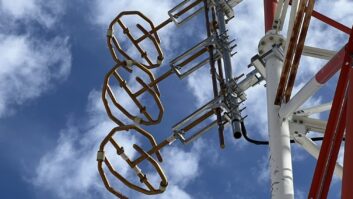The author is with the Alabama Broadcasters Association.
In light of a several recent Notices of Apparent Liability (NAL) issued by the FCC to AM stations, we thought we would remind engineers who maintain AM directional sites the importance of monitoring and documenting the operation closely.
The FCC has found that a number of stations failed to maintain required directional patterns within prescribed parameters and operate within authorized power limits.
Section 73.1560(a) of the Rules require AM station licensees to maintain their antenna input power within 90 percent and 105 percent of the authorized power. AM stations authorized power is normally determined by observing the antenna current at the feed to the tower or a line current meter at the common point during directional operation.
I realize we are “preaching to the choir” but the station engineer needs be aware that the 90 to 105 percent is the power not antenna or line current. You must calculate the required current by using simple Ohm’ Law, I = √(P/R) where I is the required current, P is power and R is tower resistance.
For example….if your station is licensed for 1000 watts then 105 percent would be 1050 watts and 90 percent would be 900 watts. For simple math assume the antenna resistance is 50 ohms, by using the above formula we find the following…
90%…..900 watts….4.24 amps
100%…1000 watts…4.47 amps
105%…1050 watts…4.58 amps
However if you have a directional AM facility operating with less than 5 kW then you allowed to increase total power 8 percent. Stations operating with more than 5 kW can increase total power 5.3 percent. This increase is to overcome losses in the phasing network. Most AM directional stations authorization has this increase already listed as the licensed power. The 90 to 105 percent limits apply to that power.
Increasing the power for the allowed percentage the above example would be….
90%……972 watts….4.40 amps
100%….1080 watts….4.64 amps
105%….1134 watts….4.76 amps
In addition to maintaining the correct power level directional stations have the added task of making sure parameters of the directional pattern are within the required tolerances. Stations are required to have a type accepted antenna monitor which allows the measurement of the phase and current ratios of each tower in the system. The authorization will list the licensed phase and current ratio for each tower. FCC rule 73.61 states the phase should be kept within +/- 3 degrees and the current ratio should stay with +/- 5 percent of values listed on the authorization.
In the event of a failure of system components, improper pattern switching or any other event that results in operation substantially at variance from the radiation pattern specified in the instrument of authorization for the pertinent time of day, operation must be terminated within three minutes unless power can be reduced sufficiently to eliminate any excessive radiation.
Each AM station using a directional antenna with monitoring point locations specified in the instrument of authorization must make field strength measurements as often as necessary to ensure that the field at each of those points does not exceed the value specified in the station authorization. Additionally, stations not having an approved sampling system must make the measurements once each calendar quarter at intervals not exceeding 120 days.
Engineers should make sure they have means to ascertain that all parameters of the station authorization are being met. One that draws a number of NAL is not being able to tell if transmission system changes day and night operations correctly. The remote control should alert the engineer of any and all improper operations. A check of these alarms should be conducted at least once a quarter.
Another comment about directional operation. Even if you have an “approved sample system” which relieves you from making routine field measurements, as station engineer you should still visit and take field measurements at least once a quarter. The antenna monitor is only indicating what is happening at the base of the tower. Things can happen in the field (large buildings constructed, new towers built, etc.) that can affect the pattern.
Engineers should also verify that the directions to the monitor points as described on the license is still valid. These can become out of date and should be updated if needed. Also, if a monitor point becomes unstable or no longer reachable, then you should file for a change of monitor point location with the Commission.
If the FCC inspector or an alternative broadcast inspector visits your facility, they will want to visit the monitor points. It would be very embarrassing to take the inspector to a monitor point and there is a large shopping center on the property. Or even more embarrassing is to not even know where the monitor points are.
Keep notes on all the readings and corrective action taken (if needed) then recorded in the transmitter maintenance log.
This article appeared in the Alabama Broadcasters Association Engineering Notebook and is reproduced with permission.








